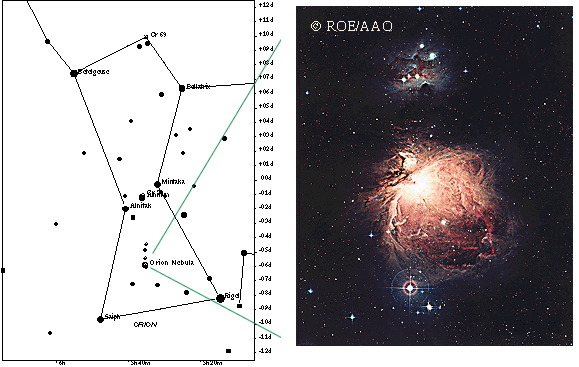
Stars live for a very long time compared to human lifetimes. Your great, great grandparents saw the same stars as you will see tonight (if it's clear). Our lifetimes are measured in years. Star lifetimes are measured in millions of years. Even though star timescales are enormous, it is possible to know how stars are born, live, and die. This chapter covers the stages a star will go through in its life and how it was figured out. The last part of the chapter will cover the remains of stars, white dwarfs, neutron stars, and the Hollywood favorite: black holes. The vocabulary terms are in boldface.
In the previous chapter you found that mass was an important quantity for determining what stars are like. In fact, all of the other aspects of a star such as its luminosity, temperature, size, density, etc., can be explained using the fundamental property of a star: its mass. There is also a slight dependence of the luminosity, temperature, size, etc. on the composition of the star, but because stars are all mostly hydrogen and helium, the star's mass is the important quantity.
Stars shine because of nuclear fusion reactions in their core. The more luminous they are, the more reactions are taking place in their cores. Massive stars live shorter lives than the common small stars because even though they have a larger amount of hydrogen for nuclear reactions, their rate of consuming their fuel is very much greater. The massive stars are analogous to the big, gas-guzzling automobiles with big gas tanks of a few decades ago and the small stars are analogous to the small economy automobiles of today that are frugal with their gasoline.
It is a simple calculation to find out how long something can continue consuming fuel. The lifetime = amount of fuel/consumption rate. If your car has a full 15-gallon gas tank and it consumes 2 gallons/hour on the highway, then your car can travel for 15 gallons/(2 gallons/hour) = 7.5 hours. Stars are the same way. The amount of fuel for nuclear fusion is proportional to the total mass of the star when it first started producing energy from nuclear reactions, so the amount of fuel = k × initial mass. The consumption rate is simply the star's luminosity, so the star will live as a main sequence star for an amount of time = k × initial mass/luminosity. If the star masses and luminosity are in units relative to the Sun (i.e, in solar masses: M*/Msun and solar luminosities: L*/Lsun), then the star's lifetime = mass/luminosity × 1010 years. Recall that the Sun's will live for ten billion (1010) years before it runs out of hydrogen in its core.
In order to remain stable via hydrostatic equilibrium, a star's luminosity increases with mass as (the star's mass)p. The value of the exponent p varies between 3 and 4. For the rare massive stars (M* > 30 Msun), p = 3 and for the more common low-mass stars (M* < 10 Msun), p = 4. You can use the mass-luminosity relation to find the star's lifetime in terms of just its initial mass. The lifetime = mass/luminosity × 1010 years is simply = (star's mass)/[(star's mass)p] × 1010 years = 1/(star's mass)p-1 × 1010 years. Remember that the star's mass is in solar masses.
How do you do that?A 5 solar mass star has only five times more hydrogen fuel than the Sun, but (the star's luminosity)/(the Sun's luminosity) = (5/1)4 = 625! Its lifetime = 1/(5/1)(4-1) × 1010 years = (1/125) × 1010 years = 8.0 × 107 years. |
Some representative lifetimes for other stars are given in the table below. Stars that have fewer elements heavier than helium in them compared to other stars, will have slightly shorter lifetimes than those given in the table.
| M*/Msun | time (years) | Spectral type |
|---|---|---|
| 60 | 3 million | O3 |
| 30 | 11 million | O7 |
| 10 | 32 million | B4 |
| 3 | 370 million | A5 |
| 1.5 | 3 billion | F5 |
| 1 | 10 billion | G2 (Sun) |
| 0.1 | 1000's billions | M7 |
A giant molecular cloud is a large, dense gas cloud (with dust) that is cold enough for molecules to form. Thousands of giant molecular clouds exist in the disk part of our galaxy. Each giant molecular cloud has 100,000's to a few million solar masses of material.

One nearby example is the Orion Nebula which you can see as the fuzzy patch in the sword part of the Orion constellation. It is about 1500 light years away and is 29 light years across. The nebula is lit up by the fluorescence of the hydrogen gas around a O-type star in the Trapezium cluster of four stars at the heart of the nebula. The O-type star is so hot that it produces a large amount of ultraviolet light. The ultraviolet light ionizes the surrounding hydrogen gas. When the electrons recombine with the hydrogen nuclei, they produce visible light. Several still-forming stars are seen close to the Trapezium stars. They appear as oblong blobs in the figure below with their long axis pointed toward the hot Trapezium stars. If you select the image, an expanded view of the Trapezium cluster will appear. Both images are from the Hubble Space Telescope (courtesy of Space Telescope Science Institute).
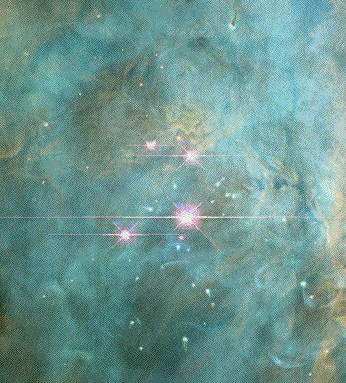
Hydrogen emission nebulae are called ``H II regions'' and they mark sites of star formation because they are formed by hot, young stars. Recall from the table at the beginning of the chapter that O-type stars live just a few million years, a very short time for a star! They do not live long enough to move out from where they were formed. Behind the visible part of the Orion Nebula is a much denser region of gas and dust that is cool enough for molecules to form. Many stars are now forming inside it.
Fragments of giant molecular clouds with tens to hundreds of solar masses of material a piece will start collapsing for some reason all at about the same time. Possible trigger mechanisms could be a shock wave from the explosion of a nearby massive star at its death or from the passage of the cloud through regions of more intense gravity as found in the spiral arms of spiral galaxies. These shock waves compress the gas clouds enough for them to gravitationally collapse. Gas clouds may start to collapse without any outside force if they are cool enough and massive enough to spontaneously collapse. Whatever the reason, the result is the same: gas clumps compress to become protostars.
A protostar will reach a temperature of 2000 - 3000 K, hot enough to glow red, but the cocoon of gas and dust surrounding them blocks the visible light. The surrounding dust warms up enough to produce copious amounts of infrared and microwave energy. This longer wavelength electromagnetic radiation can pass through the dust. Infrared telescopes and radio telescopes have observed bright clumps in many dust clouds in our galaxy. A star remains in the protostar stage for only a short time, so it is hard to catch many stars in that stage of their life. The power of infrared detectors is illustrated in the images below. The part of the nebula above and to the right of the Trapezium stars is actually forming many stars. They can only be seen in the infrared image on the right side of the figure. If you select the figure, an expanded view will appear. Both images are from the Hubble Space Telescope (courtesy of Space Telescope Science Institute).
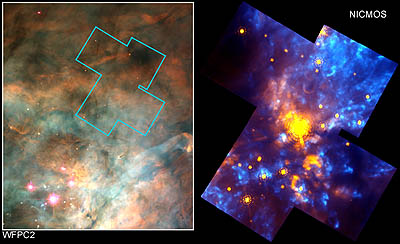
Fusion starts in the core and the outward pressure from those reactions stops the core from collapsing any further. But material from the surrounding cloud continues to fall onto the protostar. Most of the energy produced by the protostar is from the gravitational collapse of the cloud material.
Young stars are social---fragmentation of the giant molecular cloud produces protostars that form at about the same time. Stars are observed to be born in clusters. Other corroborating evidence for this is that there are no isolated young stars. This observation is important because a valuable test of the stellar evolution models is the comparison of the models with star clusters. That analysis is based on the assumption that the stars in the clusters used to validate the models all formed at about the same time.
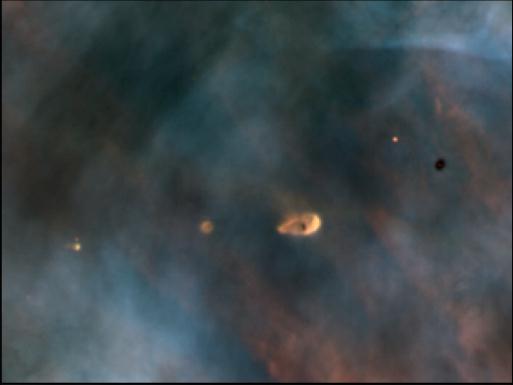
The Hubble Space Telescope has directly observed protostars in the Orion Nebula and the Eagle Nebula. The protostars it has observed have been prematurely exposed. The intense radiation from nearby hot O or B-type stars has evaporated the dust and driven away the gas around the smaller still-forming stars. In more than one case in the Orion Nebula, all of the gas has been blown away to leave just the dark dust disk with the protostar in the center. One example of a totally exposed dust disk seen almost face-on is shown in the figure above. It is the black spot to the right of the prominent cocoon nebula around the protostar at the center. The teardrop-shaped cocoon nebula around the center protostar is oriented toward the Trapezium stars to the right of the figure above. The evaporation of the dark, dense fingers of dust and gas in the Eagle Nebula was captured in the famous ``gas pillars'' picture on the right side of the figure below. Selecting the figure will bring up an expanded view of the Hubble Space Telescope image (courtesy of Space Telescope Science Institute).

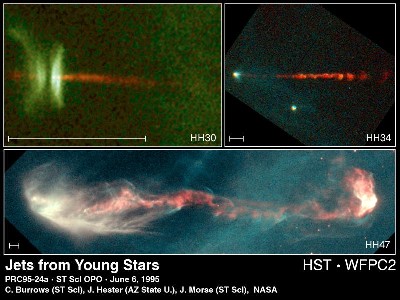
Stars initially begin their lives near other stars in a cluster. After a few orbits around the galactic center, gravitational tugs from other stars in the galaxy cause the stars in the cluster to wander away from their cluster and live their lives alone or with perhaps one or two companions. The Pleiades are a young cluster of stars easily visible in the shoulder of the Taurus (the Bull) constellation during the winter months. They are about 40 million years old (compare that to our Sun which is 4,600 million = 4.6 billion years old!). The gas and dust around the stars may be residual material from their formation or simply interstellar clouds the cluster is passing through.

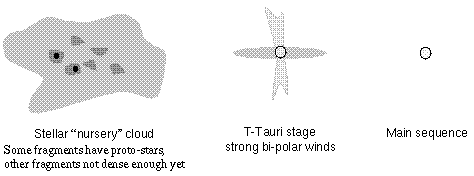
Eventually, the layer just outside the core called the ``shell layer'' gets hot and dense enough for fusion to start. The fusion in the layer just outside the core is called shell burning. This fusion is very rapid because the shell layer is still compressing and increasing in temperature. The luminosity of the star increases from its main sequence value. The gas envelope surrounding the core puffs outward under the action of the extra outward pressure. As the star begins to expand it becomes a subgiant and then a red giant.
At the bloated out surface, the energy is spread out over a larger area so each square centimeter will be cooler. The surface will have a red color because it is so cool and will be much further from the center than during the main sequence. When our Sun becomes a red giant, Mercury and Venus will be swallowed up by the Sun and perhaps the Earth will too. Even if the Earth is not swallowed up, conditions on its surface will become impossible for life to exist. The Sun's increased luminosity will heat the surface so much that the water oceans and atmosphere will evaporate away. Massive main sequence stars will expand much further to become supergiants. Betelgeuse, the bright red star in the top left corner of the Orion constellation, is an example of a supergiant star. If placed at the center of our solar system, all of the planets out to Jupiter would be inside Betelgeuse. A few supergiants are even larger than Betelgeuse!
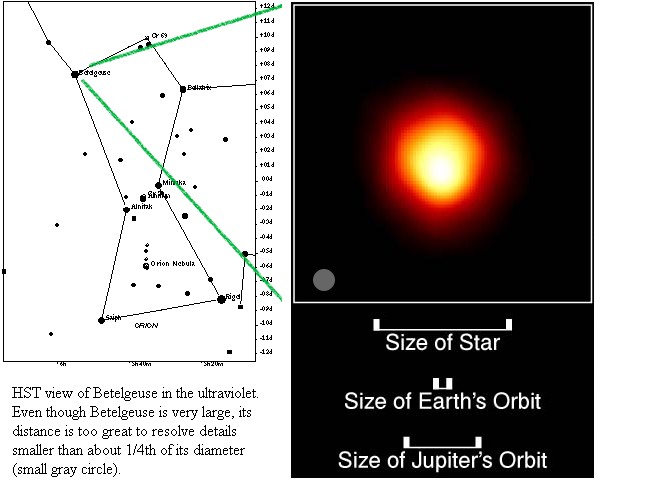
Red giants can have strong ``winds'' that dispel more mass than all of the stellar winds that occurred during the long main sequence stage. However, most of the star's mass will be lost in the ``last gasp'' stage (planetary nebula or supernova) described below. All through the star's life after it first started nuclear reactions, it has been losing mass as it converted some mass to energy and other mass was lost in the winds. This means that even though a red giant is large in terms of linear size, it is less massive than the main sequence star it came from. A red giant has the extremes in temperature and density: its surface is cold and very low density, while its core gets very hot and extremely dense.
If the star is massive enough, gravity can compress the core enough to create high enough temperatures to start fusing helium (or heavier elements if it is repeating this stage). In low mass stars (like the Sun), the onset of helium fusion can be very rapid, producing a burst of energy called a helium flash. Eventually the reaction rate settles down. Fusion in the core during this stage releases more energy/second than the core fusion of the main sequence stage, so the star is bigger, but stable! Hydrostatic equilibrium is restored until the core fuel runs out.
Stars entering and leaving this stage can create conditions in their interiors that trap their radiated energy in their outer layers. The outward thermal pressure increases enough to expand the outer layers of the star. The trapped energy is able to escape when the outer layers are expanded and the thermal pressure drops. Gravity takes over and the star shrinks, but it shrinks beyond the equilibrium point. The energy becomes trapped again and the cycle continues.
In ordinary stars hydrostatic equilibrium works to dampen (diminish) the pulsations. But stars entering and leaving stage 6 can briefly (in terms of star lifetimes!) create conditions where the pressure and gravity are out of sync and the pulsations continue for a time. The larger, more luminous stars will pulsate with longer periods than the smaller, fainter stars because gravity takes longer to pull the more extended outer layers of the larger stars back. The period-luminosity relation can be used to determine the distances of these luminous stars from the inverse square law of light brightness. This is explored further in the Milky Way chapter.
Up to the production of iron in the most massive stars, the nuclear fusion process is able to create extra energy from the fusion of lighter nuclei. But the fusion of iron nuclei absorbs energy. The core of the massive stars implodes and the density gets so great that protons and electrons are combined to form neutrons + neutrinos and the outer layers are ejected in a huge supernova explosion. The more common low-mass stars will have a gentler death, forming a planetary nebula.
In this next-to-last stage of a star's life, the outer layers are ejected as the core shrinks to its most compact state. A large amount of mass is lost at this stage as the outer layers are returned to the interstellar medium. For the common low-mass stars (those with masses of 0.08 - 5 times the mass of the Sun during their main sequence stage), the increased number of photons flowing outward from the star's hot, compressed core will push on the carbon and silicon grains that have formed in the star's cool outer layers to eject the outer layers and form a planetary nebula. The ultraviolet from the hot exposed core, called a white dwarf, causes the gases to fluoresce. Most noticeable is the red emission from the excited hydrogen and nitrogen, the green emission from doubly-ionized oxygen, and the blue emission from excited helium. Planetary nebulae can be distinguished from H II regions by their compact shape and strong emission lines of doubly-ionized oxygen (that give them their green color), doubly-ionized neon, and singly-ionized helium. (The image of the Ring Nebula on the left is courtesy of Palomar Observatory.)
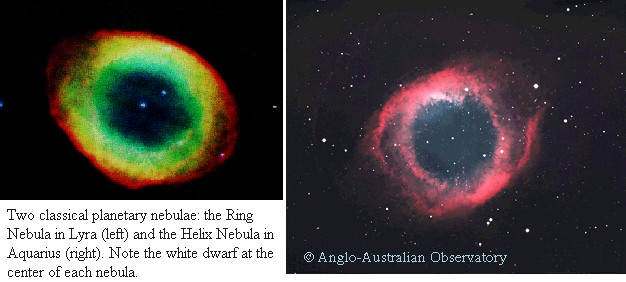
Planetary nebula get their name because some looked like round, green planets in early telescopes. They are now known to be entirely different than the planets and are about one or more light years across (much larger than our solar system!). Many planetary nebulae will look like rings (for example, the Ring Nebula in Lyra [left above] or the Helix Nebula in Aquarius [right above]) because when you look along the edge of the expanding spherical shell, you look through more material than when you look toward the center of the shell. The round soap bubbles you made as a child (or still do!) look like rings for the same reason.
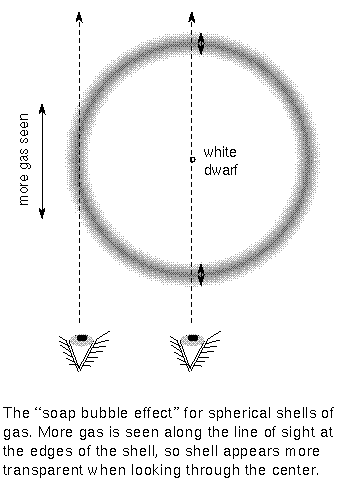
High-resolution images of planetary nebulae show complex structures in the expanding nebula. The picture below is a detailed view of the Helix Nebula from the Hubble Space Telescope. The expanding gas from the planetary nebula gas ejection runs into gas and dust dispersed in the red giant winds. As it passes the slower moving red giant wind material, the gas shapes the denser blobs into comet-like shapes. Although they are called ``comet knots'', they are not to be confused with real comets in our solar system. Each of these blobs is over twice the size of our entire solar system! If you want an enlarged view of the HST image at right, select the image.

Other planetary nebulae have a more asymmetrical appearance. The outflow is bipolar, resulting from a more complex interaction of the final outer layer ejection and the material from the stellar winds of the earlier stages. Examples of such nebulae are the Cat Eye Nebula and the Dumbbell Nebula. Selecting the image below will bring up an enlarged view of the Cat Eye Nebula.

Also, earlier jets of gas from the evolving star and companion stars may be needed to explain the complex structure of nebulae like the Hourglass Nebula shown below and why the white dwarf is not at the center of the green region in the middle. The two rings are centered along the star's poles that are oriented around 60ƒ to our line of sight. The upper ring is around the pole that is coming towards us and the lower ring is around the pole that is oriented away from us. There is evidence that the Ring Nebula in Lyra is similar to the Hourglass Nebula except that we are viewing it from right along the pole, so just one ring is seen. Select the image below to bring up an enlarged picture of the Hourglass Nebula (courtesy of Space Telescope Science Institute).
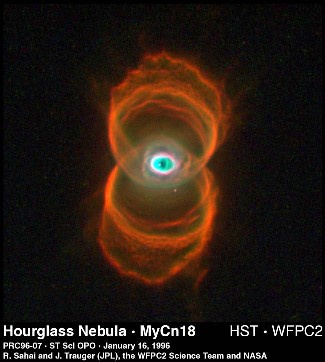
Further explanation of the causes of the sometimes bizarre shapes of the planetary nebula is available at Bruce Balick's homepage.
The rare high-mass stars (those with masses of 5 - 50 times the Sun's mass during their main sequence stage) will go the explosive supernova route. When a massive star's iron core implodes, the protons and electrons fuse together to form neutrons and neutrinos. The core, once the size of the Earth, becomes a very stiff neutron star about the size of a small town in less than a second. The infalling outer layers hit the core and heat up to billions of degrees from the impact. Enough of the huge number of neutrinos produced when the core collapses interact with the gas in outer layers, helping to heat it up. During the supernova outburst, elements heavier than iron are produced as free neutrons produced in the explosion rapidly combine with heavy nuclei to produce heavier and very rare nuclei like gold, platinum, uranium among others.
The superheated gas is blasted into space carrying a lot of the heavy elements produced in the stellar nucleosynthesis process. This explosion is a supernova. As the expanding gas crashes into the surrounding interstellar gas at thousands of kilometers/second, the shock wave heats up the interstellar gas to very temperatures and it glows. Strong emission lines of neutral oxygen and ionized sulfur distinguish their spectra from planetary nebulae and H II regions. Also, the ratio of the strengths of the individual doubly-ionized oxygen is that expected from shock-wave heating. Planetary nebulae and H II regions are lit up by the action of ultraviolet light on the gas, while supernova glow from shock-wave heating. The gas from supernova explosions also has strong radio emission with a non-thermal continuous spectrum that is produced by electrons spiralling around magnetic field lines. Gas from recent explosions (within a few thousand years ago) are visible with X-ray telescopes as well.
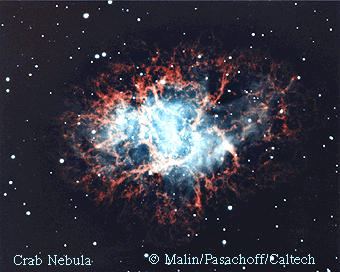
A famous supernova remnant is the Crab Nebula above. Chinese astronomers recorded the explosion on July 4, 1054 and the Anasazi Indians painted at least one picture of it. The Vela supernova (in the constellation Vela; figure below) occurred long before the Crab Nebula so it is much more spread out. Different parts of the expanding gas have run into regions of the interstellar medium of different densities. For that reason and also because there is turbulence in the expanding supernova gas, the remnant seen today is wispy strands of glowing gas.
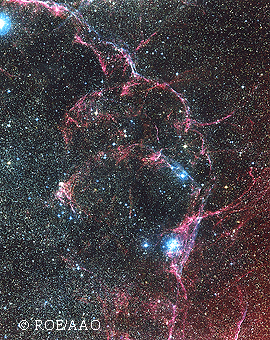
The neutrinos formed when the neutron core is created fly away from the stiff core, carrying most of the energy from the core collapse away with them. Some energy goes into driving the gas envelope outward. The rest of the energy goes into making the supernova as bright as 1011 Suns (as bright as an entire galaxy)! When a supernova occurred in a satellite galaxy of the Milky Way at the beginning of 1987 (called SN1987a), the Kakiomande neutrino detector in Japan detected a huge burst of neutrinos from the direction of the satellite galaxy. This provided confirmation of the supernova models. The images below show the star before it went supernova (right frame and arrow) and after the explosion (left frame)
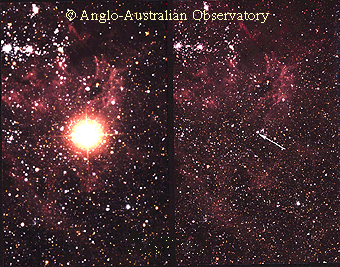
Recent views of SN1987a from the Hubble Space Telescope (below) shows the material from the supernova explosion itself expanding outward at over 9.5 million kilometers per hour preferentially into two lobes that are roughly aligned with the bright central ring. The central bright ring and two outer rings are from material ejected by the star before its death. Does this image remind you of the Hourglass Nebula above?
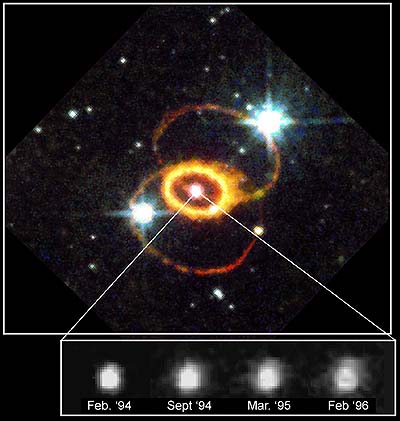
Supernovae are very rare---about one every hundred years in any given galaxy---because the stars that produce them are rare. However, there are billions of galaxies in the universe, so simple probability says that there should be a few supernovae happening somewhere in the universe during a year and that is what is seen! Because supernovae are so luminous and the energy is concentrated in a small area, they stand out and can be seen from hundreds of millions of light years away.
The bright gas nebula of a planetary nebula or supernova does not last long, only a few tens of thousands of years. As the nebula expands, it cools and dims. The processed material becomes part of the interstellar medium in the galaxy.

If the core has a mass between 1.4 and 3 solar masses, the neutrons will bump up against each other to form a degenerate gas in a neutron star about the size of small city. The neutrons prevent further collapse of the core. Nothing can prevent the highest mass cores (greater than 3 solar masses) from collapsing to a point. On the way to total collapse, it may momentarily create a neutron star and the resulting supernova rebound explosion. Gravity finally wins. Nothing holds it up. The gravity around the collapsed core becomes so great that Newton's law of gravity becomes inadequate and the gravity must be described by the more powerful theory of General Relativity developed by Albert Einstein. This will be discussed further below.
The supercompact point mass is called a black hole because the escape velocity around the point mass is greater than the speed of light. Since the speed of light is the fastest that any radiation or any other information can travel, the region is totally black. The distance at which the escape velocity equals the speed of light is called the event horizon because no information of events occurring inside the event horizon can get to the outside. The radius of the event horizon = 3 × (Mcore/Msun) kilometers.
![]() Go to
Stellar Nucleosynthesis and White Dwarf - Neutron Star sections
Go to
Stellar Nucleosynthesis and White Dwarf - Neutron Star sections
last update: 12 October 1998
(805) 395-4526
Bakersfield College
Physical Science Dept.
1801 Panorama Drive
Bakersfield, CA 93305-1219